Pages
Monday, November 29, 2021
Saturday, November 27, 2021
Thursday, November 25, 2021
1844 ALBION review of POEMS by Clement C. Moore
 |
| New York Albion - August 17, 1844 via genealogybank.com |
POEMS,
By Clement C. Moore, L. L. D. Bartlett and Welford, New York, 1844.
Here we have a volume of poems, produced by the publisher in the London style. The luxury of broad margin, fine paper, clear and beautiful type, attract the attention like any aristocratic-looking volume from the other side of the Atlantic. Indeed we thought it of English birth, until we saw the name of Wm. Van Norden, Printer. It is, in a word, a genuine specimen of good book printing, as far distant from the paltry cheap, as it is from the flimsy gew gaws now so frequently put forth to catch the eye and the penny.
The poems are from the pen of a gentleman, well known and highly esteemed in this community, who in a chaste and well written preface addressed to his children, assigns his reasons for giving his little volume to the reading world. We extract from this preface the following passages, recommending them to writers generally.
Of the poetic merits of the work we need only say, that the sentiments are chaste and moral, the versification smooth and accurate, and that the tendency of the whole is, to purify and soften the taste and to cultivate the moral perception of the reader.
We present two or three extracts:--
I do not pay my readers so ill a compliment as to offer the contents of this volume to their view as the mere amusements of my idle hours ; effusions thrown off without care or meditation, as though the refuse of my thoughts were good enough for them. On the contrary, some of the pieces have cost me much time and thought; and I have composed them all as carefully and correctly as I could.
I wish you to bear in mind that nothing which may appear severe or sarcastic in this collection, is pointed at any individual. When vice or absurdity is held up to view, it is the fault, and not any particular person that is pointed at.
LINESSENT WITH A BUNCH OF FLOWERS TO A FRIEND — MARCH, 1842.
There is a language giv'n to flowers,
By which a lover may impart
The bitter anguish that devours,
Or extacy that swells his heart.
And all the feelings of the breast,
Between the extremes of bliss and wo,
By tender flow'rets are exprest,
Or plants that in the wild wood grow.
These new-cull'd blossoms which I send,
With breath so sweet and tints so gay,
I truly know not, my kind friend,
In Flora's language what they say ;
Nor which one hue I should select,
Nor how they all should be combin'd,
That at a glance, you might detect
The true emotions of my mind.
But, as the rainbow's varied hues,
If mingled in proportions right,
All their distinctive radiance lose,
And only show unspotted white,
Thus, into one I would combine
These colors that so various gleam,
And bid this offering only shine
With friendship's pure and tranquil beam.
Fill'd as thou art with attic fire,
ANSWER TO THE PRECEDING.—BY MR. P. HONE.And skill'd in classic lore divine,Not yet content, woulds't thou aspireIn Flora's gorgeous wreath to shine ?Woulds't thou in language of the roseLessons of wisdom seek t'impart,Or in the violet's breath discloseThe feelings of a generous heart ?
Come as thou wilt, my warm regardAnd welcome, shall thy steps attend;Scholar, musician, florist, bard —More dear to me than all, as friend.Bring flow'rs and poesy, a goodly store,Like Dickens' Oliver, I ask for Moore.
TO MY DAUGHTER,ON HER MARRIAGE — 1826 [1836].
For you, my Margaret dear, I have no art
To sing a jocund hymeneal strain ;
What rises strong and deep within the heart
Must ever have some touch, at least, of pain.
Nor know I that the bird of merriest lay
Gives happiest omen in the bridal hour ;
That gaudy flowers, with brilliant tints and gay,
May best adorn the sacred nuptial bower.
But think me not of mind morose and sad,
Where naught but sullen censure finds abode,
If, in the midst of voices blithe and glad,
I greet you with a song of graver mode.
The glow on pleasure's cheek, it is not this
That always tells where heartfelt joys appear;
The hidden wellsprings of our purest bliss
Are oft betoken'd by the gushing tear.
I am not like the parent bird that tries
To lure its young one from the fostering home ;
That gladly sees its new-fledg'd offspring rise
On outspread wing, in distant shades to roam :
Yet I were form'd in Nature's sternest mood,
Did not my inmost soul with you rejoice.
To see your lot amid the wise and good,
The gentlest friends, the husband of your choice.
Mysterious bond, that kindred souls unites !
Great law of nature hallowed from above !
Bless'd remnant of lost Eden's pure delights!
The sum of all our bliss — connubial love !
Oh, holy flame ! seraphic influence mild !
Sweet incense, kindled by celestial ray !
For ever warm the bosom of my child,
And gently soothe her through life's rugged way !
And you, my child, while yet your life is strong,
While in the calm of peace your thoughts repose,
Prepare for ills that to our state belong,
And arm you to contend with numerous foes.
For many ills unseen beset us round,
And many foes within ourselves we raise.
What sudden checks in smoothest paths are found !
How few and fleeting are our golden days !
At Hymen's altar when we plight our truth,
For better and for worse, we thoughtless say;
We dream of only good ; the heart of youth
Drives ev'ry fear of distant ills away.
Till death do part, how gaily we repeat
When joy and health are in their prime and strength:
Life is a vista then whose borders meet ;
So endless, to our fancy, seems its length.
But oh ! how soon we pass this endless track,
That, like perspective art, deludes our view :
And, when we turn and on our path look back,
How short the distance ! and our steps how few !
Trust not the gilded mists and clouds that rise
Where flattering Hope and fickle Fancy reign ;
But turn from these, and seek with anxious eyes
The clear bright atmosphere of Truth's domain.
Ascend, full oft, her highest vantage ground,
And look beyond the circuit of this earth.
Review the things its narrow limits bound ;
And, with her guidance, learn to scan their worth.
Nor think that with relentless stern regard
She frowns on all our fleeting pleasures here.
Believe me, no true joys by her are marr'd,
But, in her light, more lovely they appear.
And now, while youth and health are in their bloom,
Why should you dread to look beyond this state ?
The traveller's pleasure knows no boding gloom
Because the charms of home his steps await.
Thus, like the compass, shall your tranquil soul,
With one wish'd haven steady in its view,
Though tempests rage and threat'ning billows roll,
Rest even-pois'd, and point for ever true.
 |
| New York American - October 6, 1835 |
The third poem transcribed above from the New York Albion of August 17, 1844 addresses Clement C. Moore's oldest daughter Margaret after her marriage on October 5, 1835 to John Doughty Ogden (1804-1887). Her father's sober expectation of "sudden checks in smoothest paths" proved true, too soon, when Margaret Elliot Moore Ogden passed away in April 1845, age 29.
Sunday, November 21, 2021
COSMOS aka William Carey Richards on ISRAEL POTTER
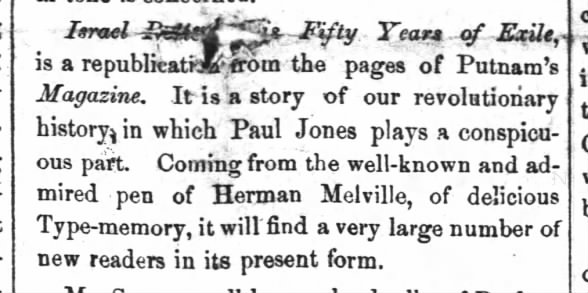
Israel Potter: His Fifty Years of Exile, is a republication from the pages of Putnam's Magazine. It is a story of our revolutionary history, in which Paul Jones plays a conspicuous part. Coming from the well-known and admired pen of Herman Melville, of delicious Type-memory, it will find a very large number of new readers in its present form.--Southern Weekly Post, March 24, 1855.
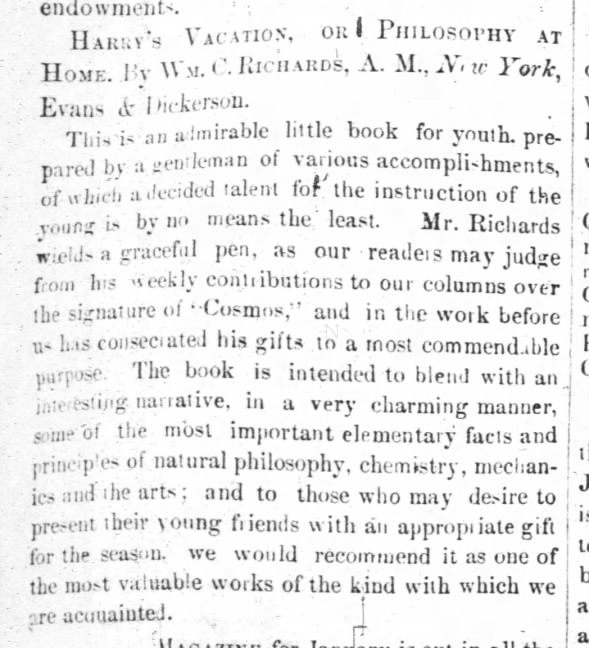 23 Dec 1854, Sat Southern Weekly Post (Raleigh, North Carolina) Newspapers.com
23 Dec 1854, Sat Southern Weekly Post (Raleigh, North Carolina) Newspapers.com"This is an admirable little book for youth, prepared by a gentleman of various accomplishments, of which a decided talent for the instruction of youth is by no means the least. Mr. Richards wields a graceful pen, as our readers may judge from his weekly contributions to our columns over the signature of "Cosmos," and in the work before us has consecrated his gifts to a most commendable purpose...."
-- Southern Weekly Post, December 23, 1854.
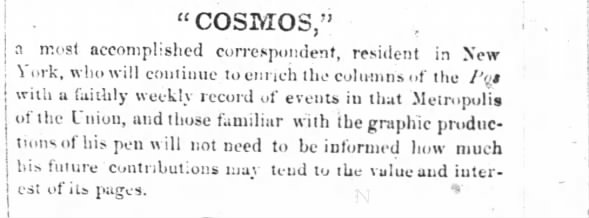
Born in London, William Carey Richards left England for the United States at the age of thirteen with his parents and siblings. The family resided in Hudson, New York for several years before moving south to Maryland and then further south to Georgia. As editor of Richards' Weekly Gazette, Richards favorably reviewed Mardi and Redburn. For the friendly reception of these and other of Melville's writings in Athens, Georgia and later Charleston, South Carolina, see the posts linked below:
- William Carey Richards on Mardi
https://melvilliana.blogspot.com/2019/05/william-carey-richards-on-mardi-and.html
- Redburn in Richards' Weekly Gazette
https://melvilliana.blogspot.com/2019/05/redburn-in-richards-weekly-gazette.html
- "Hawthorne and His Mosses" in the Southern Literary Gazette
https://melvilliana.blogspot.com/2019/05/charleston-reprinting-of-hawthorne-and.html
Wednesday, November 17, 2021
Montreal Visit from St Nicholas, 1826
"A Visit from St. Nicholas" was reprinted in the Montreal Gazette on January 4, 1826, with a helpful preface explaining the American Santa Claus to Canadians.
Amongst the Dutch Americans, St. Nicholas, or, as he is familiarly called, Sainte Claus, is a Christmas visitor, highly esteemed by the juvenile branches of families, who never fail to court the attention of the Saint, by placing their stockings, to receive such donations as this free-hearted patron of good children may in his bounty be pleased to bestow. This innocent superstition is, however, not confined to the Dutch settlers--the children of their neighbours hold the cake-bestowing Saint in equal veneration. Nor is his fame unknown in these Provinces, although he is not often seen, his gingerbread visiting-cards afford his urchin votaries a certain evidence that, whilst they slept, he has paid his annual Christmas call. We leave it to antiquaries to determine his Saintship's origin; and whether the donations made in his name originated in the distribution of sweetmeats and cakes at the Vatican at Rome, on Christmas-eve, or is a remnant of some earlier superstition. Be that as it may, we present the following picture of his garb and equipage, as it has been sketched by an American poet, who was fortunate enough to obtain a glimpse of the jolly old elf.
This item is not listed in Nancy H. Marshall, The Night Before Christmas, A Descriptive Bibliography of Clement Clarke Moore's Immortal Poem (Oak Knoll Press, 2002). With interesting exceptions, the text of the still-anonymous poem mostly follows the first printing in the Troy Sentinel on December 23, 1823. Dunder remains Dunder, for example, but Blixem has been re-christened Blixen. Also, the whole roll of reindeer names has been metrically improved by rearranging commas and exclamation marks:
“Now, Dasher! now, Dancer! now Prancer and Vixen!
“On, Comet! on, Cupid! on, Dunder! and Blixen...."
Extending to Comet and company in the second line of the couplet, the revisions to punctuation marks around reindeer names in the Montreal Gazette are even more thorough than similar changes in the Charleston Mercury and other 1826 versions. For more on those, check out the earlier post
https://melvilliana.blogspot.com/2019/12/now-dasher-in-1826.html
Another interesting difference is the addition of "which" as a relative pronoun in the distinctive heroic simile that here in this early Canadian version begins
As dry leaves which before the wild hurricane fly.
The 1823 Troy Sentinel version did not supply any word between "leaves" and "before":
As dry leaves before the wild hurricane fly.
Adding "which" makes a regular anapest "which before" in the second metrical foot. In the same line as corrected or revised in the 1844 collection Poems by Clement C. Moore, "that" replaces "which":
Santa smokes like a chimney wherever he goes, obviously. But here the é with the acute accent, unique to the Montreal Gazette version, tells readers how to sayAs dry leaves that before the wild hurricane fly.
"the smoke it éncircled his head like a wreath"in the province of Quebec.
 04 Jan 1826, Wed Montreal Gazette (Montreal, Quebec, Canada) Newspapers.com
04 Jan 1826, Wed Montreal Gazette (Montreal, Quebec, Canada) Newspapers.com
ACCOUNT OF A VISIT FROM ST. NICHOLAS.
’Twas the night before Christmas, when all thro’ the house
Not a creature was stirring, not even a mouse;
The stockings were hung by the chimney with care,
In hope that St. Nicholas soon would be there;
The children were nestled all snug in their beds,
While visions of sugar plums danc’d in their heads,
And Mama in her ’kerchief, and I in my cap,
Had just settled our brains for a long winter’s nap—
When out on the lawn there arose such a clatter,
I sprung from the bed to see what was the matter;
Away to the window I flew like a flash,
Tore open the shutters, and threw up the sash.
The moon on the breast of the new-fallen snow
Gave the lustre of mid-day to objects below;
When, what to my wondering eyes should appear,
But a miniature sleigh, and eight tiny rein-deer,
With a little old driver, so lively and quick,
I knew in a moment it must be St. Nick.
More rapid than eagles his coursers they came,
And he whistled, and shouted, and called them by name!
“Now, Dasher! now, Dancer! now Prancer and Vixen!
“On, Comet! on, Cupid! on, Dunder! and Blixen;
“To the top of the porch! to the top of the wall!
“Now dash away! dash away! dash away all!”
As dry leaves which before the wild hurricane fly,
When they meet with an obstacle, mount to the sky;
So up to the house-top the coursers they flew,
With the sleigh full of toys—and St. Nicholas too:
And then in a twinkling I heard on the roof
The prancing and pawing of each little hoof.
As I drew in my head, and was turning around,
Down the chimney St. Nicholas came with a bound.
He was dress’d all in fur, from his head to his foot,
And his clothes were all tarnish’d with ashes and soot;
A bundle of toys was flung on his back,
And he look’d like a pedlar just opening his pack:
His eyes how they twinkled! his dimples how merry!
His cheeks were like roses, his nose like a cherry;
His droll little mouth was drawn up like a bow,
And the beard of his chin was as white as the snow;
The stump of a pipe he held tight in his teeth,
And the smoke it éncircled his head like a wreath.
He had a broad face, and a little round belly
That shook when he laughed like a bowl full of jelly:
He was chubby and plump, a right jolly old elf,
And I laughed when I saw him in spite of myself.
A wink of his eye and a twist of his head
Soon gave me to know I had nothing to dread.
He spoke not a word, but went straight to his work,
And fill’d all the stockings; then turn’d with a jirk,
And laying his finger a side of his nose
And giving a nod, up the chimney he rose.
He sprung to his sleigh, to his team gave a whistle,
And away they all flew like the down of a thistle:
But I heard him exclaim, ere he drove out of sight—
"Happy Christmas to all ! and to all a good night."
-- Montreal Gazette, January 4, 1826.
Monday, November 15, 2021
1857 Night before Christmas
Illustrated by Jacob A. Dallas (1825-1857) and published in the January 1857 number of Mrs Stephens' New Monthly magazine.
 |
| Mrs. Stephens' Illustrated New Monthly Vol. 2 - January 1857 |
Friday, November 12, 2021
The ladies who launched Santa Claus
Transmission history
The piece was first published in the Troy Sentinel, on December 23, 1823, with an introductory notice by the Editor, Orville L. Holley, Esq., and again two or three years after that. At the time of its first publication I did not know who the Author was — but have since been informed that you were the author. I understood from Mr. Holley that he received it from Mrs. Sackett, the wife of Mr. Daniel Sackett who was then a merchant in this city. It was twice published in the Troy Sentinel; and being much admired and sought after by the younger class, I produced the engraving which you will find on the other side of this sheet, and have published several editions of it.
--Accessible via the Museum of the City of New York
https://www.mcny.org/story/clement-clarke-moore-and-santa-city
These lines were composed for his two daughters, as a Christmas present, about 40 years ago.—They were copied by a relative of Dr. Moores in her Album, from which a copy was made by a friend of hers, from Troy, and, much to the surprise of the Author, were published (for the first time) in a Newspaper of that city.—
-- Letter from T. W. C. Moore to the Librarian of the New-York Historical Society, dated March 15, 1862 and first published in The New York Historical Society Quarterly Bulletin 2.4 (January 1919) pages 111-115.
Most likely Sarah Sackett was the second copyist, the Troy "friend" of the visiting "relative" who first copied the lines into her "Album" or commonplace book from the author's manuscript. The identity of the first copyist was revealed, maybe for the first time, in the account that "Colonel" John Tappan Parker supplied to the Troy Daily Times where it was printed on December 23, 1871. Transcribed below, the published 1871 testimony from John T. Parker, a well-informed and well-respected citizen of Troy NY, has received comparatively little attention from commentators on the authorship of The Night Before Christmas.
THE "VISIT OF ST NICHOLAS"—MOORE'S POEM—SOME ACCOUNT OF ITS HISTORY—There is scarcely a boy or girl in the land who has not read the poem entitled "A Visit of St. Nicholas," commencing with the familiar lines:
" 'Twas the night before Christmas, when all through the houseNot a creature was stirring, not even a mouse."and there are many who even know the poem by heart. It has preserved the author's name from oblivion; and it is an interesting fact to know that Mr. Moore was indebted to a Troy lady for first bringing it to the notice of the public. Indeed, the poem seems to have had something of a Trojan origin; the circumstances of which our well known fellow-citizen John N. Parker [typo for John T. Parker, T for Tappan], thus recounts in a letter to the Times:Presuming you will publish, as usual, the "Visit of St. Nicholas," quoted above, I send you the enclosed history of it for the benefit of the young Trojans who sleep with one eye open on the night before Christmas. As it has a Trojan birth, it may interest even the editor to hear its narrative as related by me. In the year 1825 I think [1822, actually], the eldest daughter of Rev. David Butler, first rector of St. Paul's church, Miss Harriet Butler, on a visit to Prof. Clement C. Moore of Columbia College, New York, found on the centre table this 'Visit of St. Nicholas,' composed by the Professor for his children. Miss B. brought it to Troy with her, and gave a copy of it to O. L. Holley, the editor of the Troy Sentinel, published by Norman Tuttle. It took like wildfire, and was copied through the state. The Troy Sentinel printed it for the news boys for several years on Christmas day. Myron King executed a beautiful wood cut, representing St. Nicholas on his sleigh, drawn by six reindeer prancing up a steep house-top, and entering the chimney with his presents. In proof of its popular character, I have before me a beautiful copy of "American Poets," printed in London, and the first poem is the "Visit of St. Nicholas"—a deserved compliment to the country and author. Wishing you and yours a right merry Christmas, Mr. Editor, I remain yours,
JOHN T. PARKER.
-- Troy Daily Times. December 23, 1871: 3 col 1.
Reprinted in the Rochester Democrat and Chronicle on Christmas Day 1871:
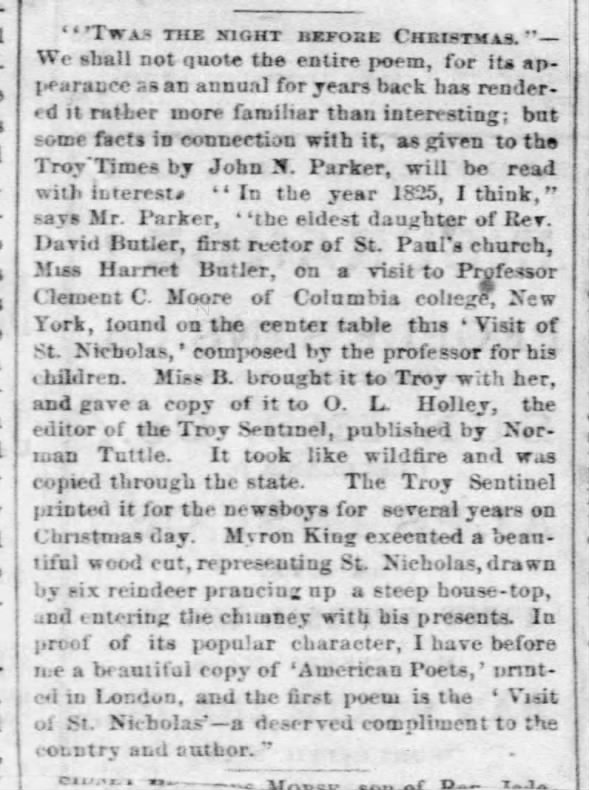
A longtime resident of Troy, John T. Parker (1803-1874) must have known Miss Harriet Butler (1791-1865), the Troy lady he credits by name with copying "Visit" and supplying it to Orville L. Holley. And Harriet's younger brother, Clement Moore Butler. Parker's 1871 narrative is informed by personal knowledge of Troy and its leading citizens including their father, the well-regarded pastor of St. Paul's Episcopal Church. Indeed, Harriet's father David Butler officiated in 1834 at the wedding of John T. Parker and Martha Lasell.
MARRIED. On Wednesday afternoon, at St. Paul’s Church, by the Rev. David Butler, Mr John T Parker to Miss Martha Lasell, daughter of Mr Elias Lasell, all of this city.
-- Troy Budget, January 10, 1834.
John's wife Martha Lasell Parker (1810-1903) attended the Troy Female Seminary, as the Emma Willard School was then called. Fourteen-year-old Martha Lasell was still a pupil there in September 1824 when the ladies of Troy welcomed the Marquis de Lafayette during his triumphant tour of the United States. As reported previously on Melvilliana, Lafayette was persuaded to visit the Female Seminary after receiving a formal invitation signed by Emma Willard and eleven leading women on the Committee of Arrangements including Harriet Butler and Sarah Sackett. The names of the two ladies who introduced Santa Claus to Troy in December 1823 appeared together on the signed note to General Lafayette from the Committee of Arrangements.
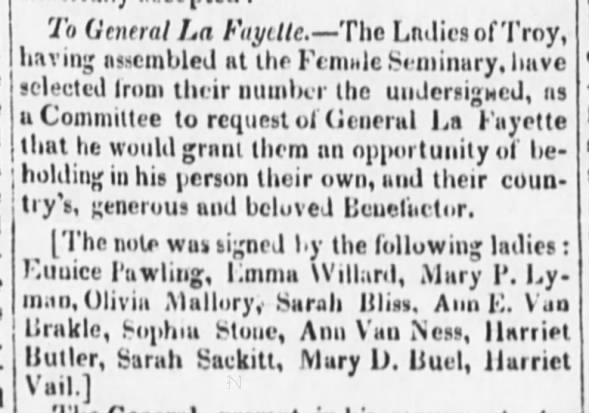
To General La Fayette.— The Ladies of Troy, having assembled at the Female Seminary, have selected from their number the undersigned, as a Committee to request of General La Fayette that he would grant them an opportunity of beholding in his person thier own, and their country's, generous and beloved Benefactor.
[The note was signed by the following ladies: Eunice Pawling, Emma Willard, Mary P. Lyman, Olivia Mallory, Sarah Bliss, Ann E. Van Brakle, Sophia Stone, Ann Van Ness, Harriet Butler, Sarah Sackitt, Mary D. Buel, Harriet Vail.] --New York Evening Post, September 23, 1824.
As a schoolgirl, John T. Parker's future wife Martha Lasell Parker may already have known both Harriet Butler and Sarah Sackett. Near the close of the 19th century, Martha recalled the visit of Lafayette as a highlight of her time at the Troy Female Seminary:
When La Fayette visited the school in 1824, Miss Lassell was still at the Seminary, and participated in the ovation paid to him. The young girls were dressed in white frocks and gay ribbons. A bower of evergreen was erected across the Park to the Seminary building.
Mrs. Willard, attended by her teachers, met General La Fayette at the north gate, while the scholars followed in line, singing an ode of welcome which Mrs. Willard had written for the occasion. --Emma Willard and Her Pupils, edited by Mrs. A. W. Fairbanks (New York: Mrs. Russell Sage, 1898) page 74.
Harriet Butler was 32 years old in 1823; Sarah Sackett just 30 when she reportedly handed Orville Holley a copy of "A Visit from St Nicholas" for publication in the Troy Sentinel. Ten months later they collaborated with Emma Willard and others on the reception of Lafayette. Perhaps other civic and charitable projects brought them together as well, although they worshipped in different places--Harriet of course at St. Paul's Episcopal Church, Sarah at the First Presbyterian Church. Were Miss Butler and Mrs. Sackett ever employed by Mrs. Willard as teachers or assistants at the Troy Female Seminary?
Harriet Butler died in 1865, on the day after Christmas.
 |
| Troy Daily Times - December 29, 1865 |
 |
| Troy Sentinel - April 27, 1827 via NYS Historic Newspapers |
Sarah H. Sackett died in Lansingburgh on June 23, 1867, eighteen months after the passing of her Troy friend Harriet Butler.
 |
| Troy Weekly Times - June 29, 1867 via NYS Historic Newspapers |
DIED.
... In Lansingburgh, at the residence of her nephew, Wm S. Hawley, June 23d, Mrs SARAH H., relict of Daniel Sackett, late of Troy, aged 74 years. --Troy Weekly Times, June 29, 1867
The perfunctory announcement of Sarah Sackett's death in the Times prompted this heartfelt tribute signed "E. D." and published in the Troy Daily Times on July 6, 1867.
 |
| Troy Daily Times - July 6, 1867 via fultonhisotry.com |
Obituary.
When an aged saint whose Christian course for more than two score of years has been one of untiring faithfulness and well-doing in the church of Christ, a life-long exhibition of kindness and good will to all around; I say when such a one departs this earthly tabernacle, the occasion seems to demand something more than a passing notice in a daily journal. Such a one has recently been suddenly stricken down in the midst of continued usefulness in the church and the world. All who were familiar with the dear expressive face, the gentle, graceful Christian manners and conversation of the late Mrs. Daniel Sackett, were pained when they read in the Times a few days since, the words which told them of her demise. Though Mrs. S. had not been a constant resident of Troy for a few years past, yet she retained her connection in the communion of the Second Presbyterian Church, Fifth street. Only two weeks previous to her death she came back to the city to spend a Sabbath of sacramental privileges with the church of her earlier love. Though the old church building, dear to the memory of all hearts who once worshipped there, had been swept away by the "destruction that wasted at noonday" and a more beautiful and commodious one erected, yet to her heart, a more thrilling and heart-touching memory must have come, when she remembered that of all that goodly company with whom she united more than forty years by-gone, in the original organization of that same church, probably but one with herself was spared by the hand of death or change to sit down on that occasion at the table of the Lord.
But her work is done, she has gone to her rest quietly, peacefully--gone to the fellowship of Heaven--to a blessed re-union with one, to her, "not lost, but gone before," and to whose memory, her widowed life ever paid a beautiful tribute of devotion.
E. D.
"was very intimate in the family at Hyde Park, and he read to the children his much beloved poem “The Night Before Christmas” from the manuscript before it ever was published."
-- Historical Notes of St James Parish, Hyde Park-on-Hudson, New York (Poughkeepsie, 1913) page 38.
As far as we know, however, not one of those lucky Bards was bold enough to copy Moore's poem and share it with others via the local newspaper.
Holiday Toast from Melvilliana
[Nineteenth-century style, to be drunk standing.]
Here's to the ladies of Troy who launched Santa Claus and fêted Lafayette... true in heart and soul, they knew what to do with a "generous and beloved Benefactor."
 |
| via Library of Congress |
- Harriet Butler and Sarah Sackett in Troy, 1824
https://melvilliana.blogspot.com/2018/12/harriet-butler-and-sarah-sackett-in.html
- First printing of A Visit from St Nicholas
https://melvilliana.blogspot.com/2019/04/first-printing-of-visit-from-st-nicholas.html
Thursday, November 11, 2021
Eric Clapton - Black Magic Woman | The Lady In The Balcony: Lockdown Ses...
Tuesday, November 9, 2021
Monday, November 8, 2021
Sanity regained
"It is the distinction of these two fine books that they restore Melville scholarship to normalcy."
-- Edward Wagenknecht, reviewing Herman Melville, a Biography by Leon Howard and Melville's Early Life and Redburn by William H. Gilman for the Chicago Sunday Tribune, October 21, 1951.
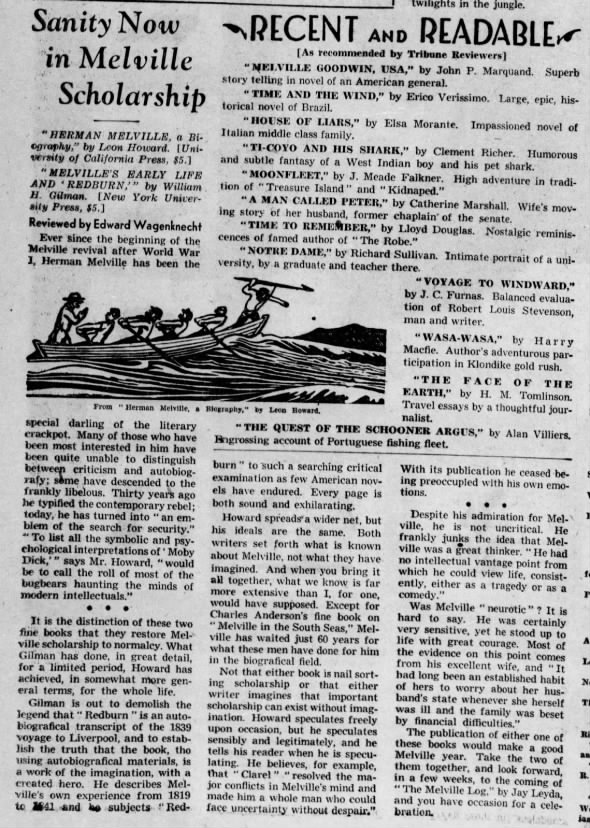 21 Oct 1951, Sun Chicago Tribune (Chicago, Illinois) Newspapers.com
21 Oct 1951, Sun Chicago Tribune (Chicago, Illinois) Newspapers.com
Saturday, November 6, 2021
Fragments from a Writing Desk: I copied Cleanth Brooks's letters years ago and ca...
"You’ll see that I take your hypothesis very seriously. I trust that you will publish the article—and soon. But if I am to be helpful in any way to you, it behooves me to set down what I think is improbable in your theory. Maybe these notes will suggest ways to you for strengthening your theory. Anyway, I send them in a spirit of cooperation being more and more certain in my own mind that sound scholarship is increasingly a cooperative enterprise."


